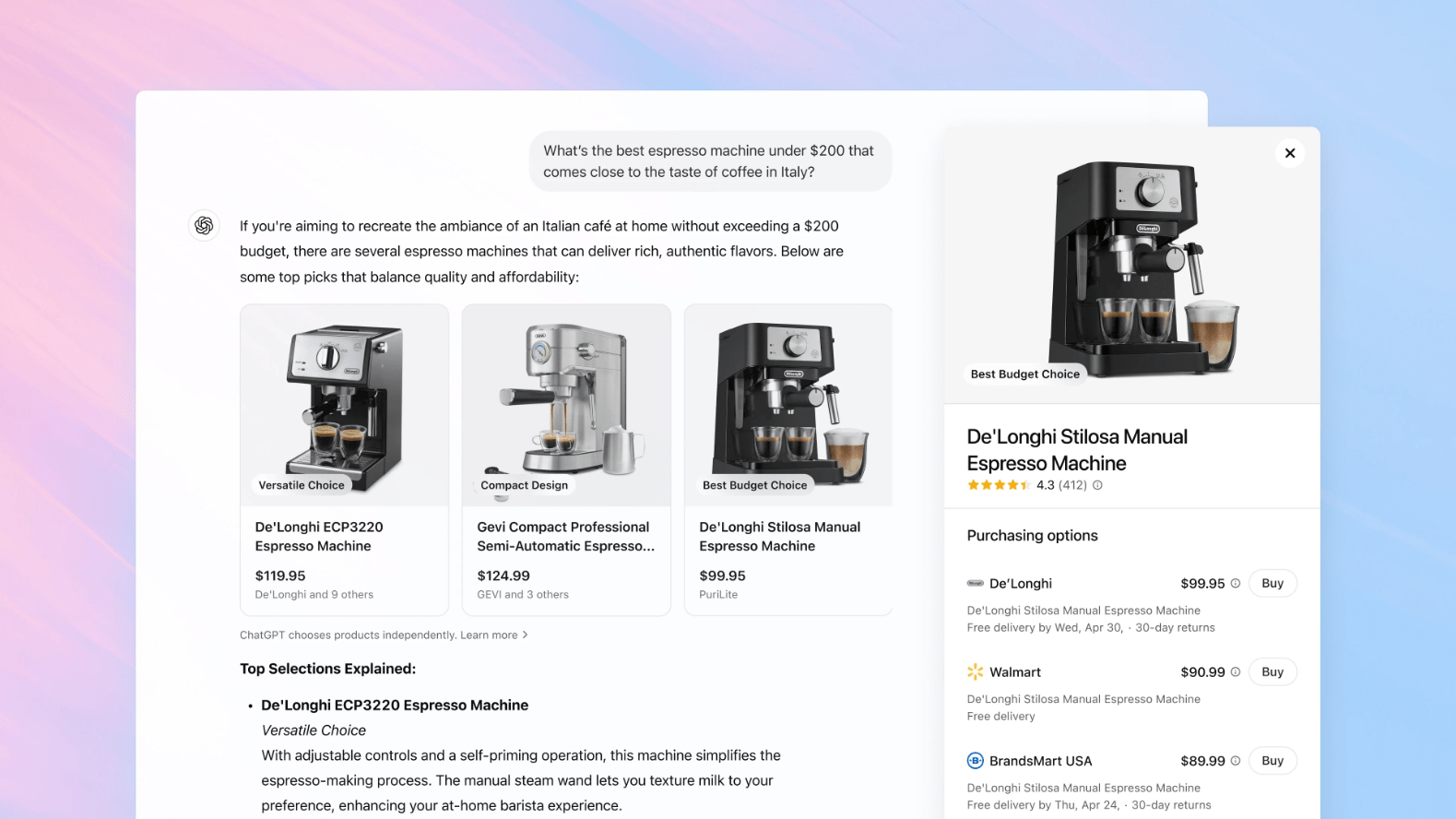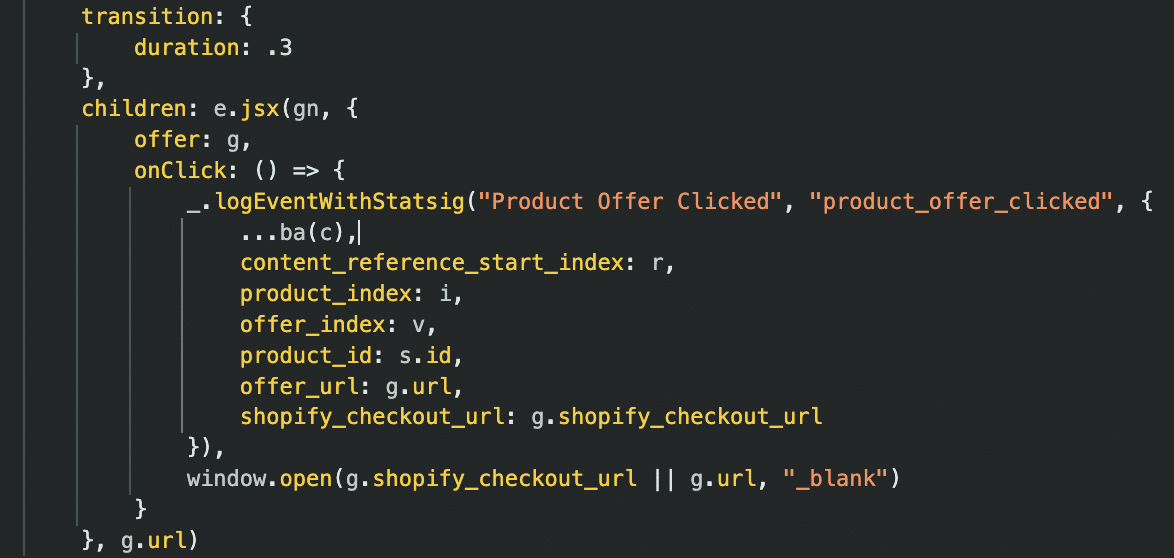Chat GPT Shopping: how conversational AI is redefining the online shopping journey
01/10/25
8'
Conversational artificial intelligence is no longer limited to generating text. It is now entering a new phase: conversational commerce. Since late April 2025, OpenAI has introduced Chat GPT Shopping, a feature that allows users to search, compare, and buy products directly within ChatGPT, without using a traditional search engine or e-commerce platform.
This development marks a profound shift in consumer digital habits and, more importantly, a strategic turning point for brands, retailers, and digital marketers.
Go further
A conversational, seamless, and personalised shopping experience
With ChatGPT Shopping, online purchasing becomes conversational. Users can now make simple requests such as: “Which coffee machine would you recommend for under €100?” or “Show me trendy white trainers,” and receive a tailored selection of products with comprehensive information in return.
Each result comes with a detailed product card: images, price, customer reviews, technical specifications, and sometimes even tags like “Popular” or “Best value for money”. The aim is to simplify the search phase while intelligently guiding the user’s decision.
This experience is powered by real-time analysis of purchase intent, based on several combined signals: query content, previous interactions, commercial relevance, and product popularity on merchant sites. Unlike traditional search engines, results are neither sponsored nor promotional (at least for now).

In most cases today, when a user interacts with ChatGPT Shopping, they are still redirected to the merchant’s website to complete the purchase. The assistant acts as a smart recommendation engine, capable of simplifying the discovery phase and guiding users to the right product, but not handling the transaction directly.
More innovative still: a beta version of the feature now allows users to complete purchases without ever leaving ChatGPT. Thanks to direct integration with Shopify’s payment module, the assistant now covers the entire e-commerce journey from product discovery to transaction, within a seamless, uninterrupted interface.
Leak of a code demonstrating the possibility of making a purchase with ChatGPT
Source testingcatalog.com

The next step: Instant Checkout and the Agentic Commerce Protocol
In September 2025, OpenAI unveiled a decisive advancement: Instant Checkout, powered by the Agentic Commerce Protocol co-developed with Stripe. This new standard enables users not only to discover but also to purchase products directly within ChatGPT, in just a few taps. Starting with Etsy sellers in the United States and soon expanding to millions of Shopify merchants such as Glossier, SKIMS, and Spanx, Instant Checkout transforms ChatGPT into a true end-to-end shopping interface.
Unlike the first beta integrations, the Agentic Commerce Protocol introduces an open standard for AI commerce. It allows AI agents, users, and businesses to collaborate securely while keeping merchants in control of their payments, order management, and customer relationship. For shoppers, the experience is frictionless: search, compare, and buy without leaving the conversation. For merchants, it means a direct connection to hundreds of millions of active ChatGPT users while maintaining their existing backend and payment systems.
This milestone marks the beginning of agentic commerce: a future where conversational AI doesn’t just recommend products but actively handles transactions, reshaping how and where purchase decisions are made.
Strategic implications for e-retailers and brands
This evolution raises key questions for retail and e-commerce professionals:
- What impact on traffic from traditional search engines?
- Integrating shopping into ChatGPT could divert part of the traffic from Google or Amazon by capturing product queries right at their source. Users no longer need to go through a search engine to compare or buy, which redefines the role of SERPs in the purchase journey.
- How can you make your products appear in ChatGPT results?
- For now, results are not sponsored. Products are selected based on relevance, popularity, and the quality of provided data (title, price, reviews, availability, etc.). It’s therefore crucial to optimise your catalogue according to GEO (Generative Engine Optimization) principles.
- What levers can be activated to capture purchase intent on these new interfaces?
- Brands should focus on clear, structured, conversational content that responds directly to naturally phrased needs. High-quality product descriptions, updated data, and presence on compatible platforms (like Shopify) are key levers.
In the long term, generative AI (currently ChatGPT) could become a primary acquisition channel on par with Google or Amazon. This will require a reinvention of visibility strategies, as well as an adaptation of product feeds, descriptions, and structured data (images, reviews, dynamic pricing).
GEO: the new AI-driven SEO
This upheaval in online product search is giving rise to a new area of expertise: GEO, or Generative Engine Optimization. Much like SEO (Search Engine Optimization) aims to rank websites on Google, GEO aims to maximise brand visibility within AI-generated responses from tools like ChatGPT.
But unlike SEO, which follows the rules of classic ranking algorithms, GEO demands adaptation to a generative, conversational logic. Here, AI doesn’t merely index pages. It synthesises answers based on purchase intent, drawing from a multitude of signals. To be surfaced and recommended, a product must meet several criteria:
- Impeccable semantic quality: product pages must be well-structured, clearly written, and use natural language aligned with how users formulate queries
- Up-to-date, exhaustive data: pricing, availability, delivery fees or return conditions must be accurate so the AI can generate relevant results
- Coverage of specific user needs: content should address nuanced, real-world questions (“Which ergonomic chair is best for remote work?” rather than just “Office chair”)
- Relevance in a conversational context: AI will favour offers that flow naturally in dialogue, with good value for money, positive reviews, and standout features in carousel-style results
Some agencies and platforms are already taking up the challenge. JVWEB, for instance, is structuring its offering around GEO, approaching it as the SEO equivalent for generative AI. Havas Market, meanwhile, is developing tools that analyse brand visibility and performance across AI-powered interfaces to optimise activation strategies on these new channels.
GEO is fast becoming a discipline in its own right. Soon, the challenge won’t just be to rank on Google, but to make your products understandable and attractive to an AI that communicates with consumers in real time.
What’s next? A new e-commerce model in the making
The launch of ChatGPT Shopping isn’t just a one-off technological innovation. It reflects a broader trend: a fundamental transformation of purchase journeys and decision-making interfaces.
Until now, product search followed a well-trodden path: search engines (like Google), comparison tools, marketplaces (Amazon, Cdiscount, etc.), followed by product page browsing. This process, fragmented, ad-saturated, and optimised more for conversion than clarity, is now showing its limits compared to a new promise: AI-assisted shopping.
With a smooth, personalised interface free from commercial distractions, ChatGPT Shopping redefines the user experience. In just a few conversational lines, a user can:
- Explore a curated selection of genuinely relevant products
- View aggregated reviews from multiple platforms (Amazon, Best Buy… even Reddit!)
- Ask naturally phrased questions, as they would to a real sales assistant
This new model has the potential to massively divert traffic from traditional channels:
- Google Shopping could lose its central role in product discovery if users stop clicking on ten sponsored links and instead rely on a single direct answer
- Amazon, long-dominant in internal product search, may see its hold threatened if consumers no longer need to visit the platform to receive relevant recommendations
- TikTok Shop or Instagram Shopping, though on the rise, could also face stiff competition in terms of algorithmic relevance and instant answers
This shift raises a vital strategic question: where will future purchase decisions actually be made?
If the answer becomes “within an AI-powered conversational agent”, then brands, distributors, and retailers must adapt their strategies. That means:
- Integrating into these conversational ecosystems (via structured feeds, enriched product data, and a GEO strategy)
- Evolving their digital presence to be understood and promoted by generative engines
- Breaking down SEO/SEA/social silos to adopt a multichannel approach driven by AI
Finally, one of the most critical issues could be control over the purchase funnel, now concentrated in a single interface. If ChatGPT ultimately enables full transaction completion directly in the assistant (via Shopify or others), then the current e-commerce model must be reimagined: fewer product pages, more intelligent interfaces; fewer click-based acquisitions, more presence in generated responses.
The brands that adapt early to this new paradigm will gain a clear competitive edge. Those who wait risk losing visibility to competitors who’ve already learned to speak the language of AI.
For brands, the message is clear: be present where purchasing decisions are now made. And that also means integrating into conversational ecosystems.
Your e-commerce library
Sign up for our newsletter
By submitting this form you authorize Lengow to process your data for the purpose of sending you Lengow newsletters . You have the right to access, rectify and delete this data, to oppose its processing, to limit its use, to render it portable and to define the guidelines relating to its fate in the event of death. You can exercise these rights at any time by writing to dpo@lengow.com

Trending Posts
Marketing channels
ChatGPT Ads and advertising on GenAI Search Engines: what you need to know
Advertising on generative AI-based search engines (GenAI) marks a new era in digital marketing. After two decades dominated by traditional…
22/05/25
6'
Marketing channels
Reddit and Social Commerce: When Users Take Back Control
Before buying anything, we compare. We hesitate. And more and more often, we end up typing the product name followed…
30/06/25
8'
Marketing channels
How to Sell on TikTok in 2025: The Ultimate Guide to Success
To sell or not to sell on TikTok? That remains a question many brands ask themselves. But here’s what you…
03/02/25
7'
E-commerce Trends
E-Commerce 2025: The New Rules of Digital Retail
What’s going on in e-commerce? A lot. If 2024 was the year brands got comfortable with marketplaces, AI tools, and…
11/07/25
8'
Marketing channels
Omnichannel Strategy: The Best Examples of Successful Brands
Consumers interact with brands through multiple channels, including online, in-store, and mobile apps. More than 90% of consumers expect a…
04/04/25
5'




